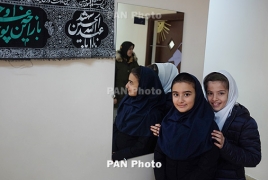 Piece of Iran in YerevanShahid Fahmideh school The relations between Armenia and Iran count thousands of years, although they had not always been friendly. After the Republic of Armenia regained independence, the two states engaged in close cooperation, strengthening economic and cultural ties. As result of this cooperation, Shahid Fahmideh school opened at the Iranian embassy in Yerevan over 20 years ago. PAN visited the school and talked to principal Afshin Mahmoudvandi, while PAN Photo took the photographs of the educational institution. PanARMENIAN.Net - The school is located behind a high fence and iron gates. Getting inside, you step out of Armenia and find yourself in Iran. There are portraits of the country’s Supreme Leader and President and extracts from Koran on the walls. All the girls, even the smallest ones are wearing headscarves. The school curriculum is developed in line with Iran’s educational standards both for Iranian and Armenian students. The only exception is that the school in Yerevan is not segregated, although the barrier between boys and girls is easily observed (students sit in different rows). Principal Mahmoudvandi says that the reason for co-education is the small number of students (about 150) and assures that it’s the only differences from the schools operating in Iran. Mohammad Hossein Fahmideh (1967-1980) is an Iranian war hero and an icon of the Iran–Iraq war. According to his official biography, when the war broke out, Fahmideh was a 13-year-old boy from Qom. He left his home without his warning his parents and went to the frontline. In one of the fierce battles, seeing that his older brothers-in-arms were already dead or wounded, Fahmideh put on a grenade belt from a nearby body, pulled the pins out, and jumped underneath an advancing Iraqi tank, killing himself and disabling the tank. This made the Iraqi tank column believe that Iranians mined the area and cease their advance. Fahmideh was posthumously awarded the 1st grade Fath Medal (Victory Medal). About the school The school is open 6 days a week from 9 am to 2 pm. Most of its students are the children of the Iranian embassy and cultural center employees. There are also kids from Iranian-Armenian families, who moved to live in Yerevan. The building consists of six parts, including the sections for the junior and senior grade students, gym and canteen. There is also a small guesthouse, which hosts inspectors arriving from Georgia, Iran or Turkey. The school offers all conditions essential for the educational process: well-equipped classrooms, professional teaching staff and a room for namaz. There is also a computer room, library and an event hall. The outdoor territory is about 2000 square meters, where new sports equipment was installed with the assistance of the Nor Nork district administration. Mahmoudvandi says that majority of schools in Iran can’t afford such ‘luxury’. Curriculum The lessons are taught in the Persian language with the textbooks published in accordance with the Iranian standards. Religion classes are the inseparable part of the curriculum, during which the students study the Koran and make namaz. It should be noted that Armenian-born students are free not to attend these classes. Instead, they study the Armenian language. The educational program also includes sightseeing and visits to museums. “Our students live and grow up in Armenia and we would like them to know the history and sights of this hospitable country,” the principal says. Teaching staff The school teachers mostly arrive from Iran. Principal Mahmoudvandi assures they invited the best tutors, who had to pass special exams. They are granted diplomatic status and are rated as embassy employees. Similar Iranian schools operate in 85 countries. Besides, the Armenian Ministry of Education and Science and the Ministry of Sports invited the teachers of the Armenian and English languages, as well as physical culture. The general curriculum provides for 5-day educational week. However, Iranian students can attend on Saturdays as well: for the Armenian and English classes, which are optional. Music classes are supposed to be introduced soon. The annual education fee is AMD 200,000 for the primary school; 250,000 for the 7th-9th grade students and 300,000 for the 10th-12th grade students. Kristine Kyurklyan / PanARMENIAN.Net Marriages by mail Green tourism on the rise in Syunik This winter is ideal for it The cableway, the shoe and the unicycle The growing trend of human microchipping Holy Etchmiadzin prefers solar energy Friendship heals |